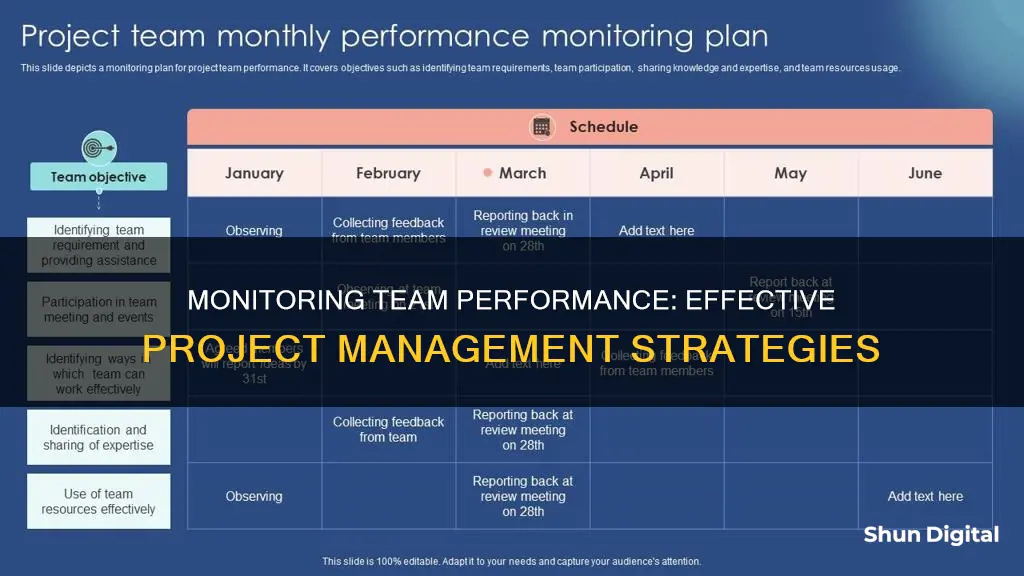
Monitoring team performance in project management is an essential aspect of keeping projects on track and ensuring successful outcomes. It involves tracking metrics such as schedule performance, cost variance, resource utilisation, and risk assessment to identify potential issues and ensure that tasks are completed on time, within budget, and according to project requirements. Effective monitoring enables project managers to make data-driven decisions, optimise resource allocation, control costs, and manage stakeholder expectations. It also plays a crucial role in fostering accountability, improving team engagement, and enhancing overall project quality. By utilising tools like project management software and performance monitoring tools, project managers can streamline the monitoring process, gather valuable insights, and make timely interventions to guide projects towards successful completion.
What You'll Learn

Monitoring Team Performance: Feedback and Accountability
Monitoring team performance is an essential aspect of project management. It involves tracking metrics such as schedule performance, cost variance, resource utilisation, and risk assessment to ensure that projects stay on track and meet their intended goals. This process is crucial for identifying potential issues and keeping teams aligned with project objectives.
Feedback and Accountability
Feedback and accountability are integral components of monitoring team performance. They facilitate open communication, promote employee engagement, and establish clear expectations for team members.
Feedback
Feedback is a critical tool for enhancing team performance. It provides valuable insights into what is working well and what areas need improvement. Regular feedback helps team members understand their strengths and weaknesses, fostering a culture of continuous improvement.
Encouraging constructive feedback creates a healthy dynamic within the team. It enables team members to express their thoughts, concerns, and suggestions, leading to higher engagement and motivation.
Additionally, feedback helps team leaders make data-driven decisions. By collecting and analysing feedback data, leaders can identify patterns, address common challenges, and optimise processes to improve overall performance.
Accountability
Accountability is the cornerstone of effective team performance monitoring. When team members set clear goals and understand their responsibilities, they are more likely to be committed to their work and strive towards their full potential.
Setting relevant and realistic goals is essential for fostering accountability. Goals should be specific, measurable, aligned with the team's objectives, achievable, and time-bound (SMART goals). This provides a clear framework for evaluating performance and enables team members to track their progress.
Regular check-ins and performance evaluations further enhance accountability. During these meetings, team members can discuss their milestones, challenges, and achievements, ensuring everyone remains on the same page and enabling leaders to provide timely support or course corrections.
Benefits of Monitoring Team Performance
Monitoring team performance offers several advantages, including:
- Improved decision-making: By tracking key performance indicators (KPIs) and conducting regular evaluations, leaders can make data-driven decisions, optimising processes and resource allocation.
- Enhanced transparency: Regular monitoring provides a clear picture of the team's progress, eliminating guesswork and promoting transparency across the team.
- Early issue identification: Systematic monitoring acts as an early warning system, helping leaders spot deviations from planned parameters and address potential problems before they escalate.
- Better resource utilisation: Monitoring performance allows leaders to allocate resources efficiently, ensuring that team members are not overwhelmed and that resources are used optimally.
- Increased stakeholder satisfaction: Regular updates and clear visibility into project progress boost stakeholder confidence and satisfaction.
Best Practices for Monitoring Team Performance
To effectively monitor team performance, consider the following best practices:
- Set clear expectations: Clearly outline project goals, milestones, and individual responsibilities from the outset.
- Utilise monitoring tools: Leverage project management software and automation to streamline data collection, performance tracking, and reporting.
- Encourage open communication: Foster a culture of ongoing communication where team members feel comfortable sharing updates, challenges, and feedback.
- Conduct regular check-ins: Schedule regular one-on-one and team meetings to discuss progress, address concerns, and provide support.
- Recognise and reward: Motivate team members by recognising their achievements and providing rewards to boost morale and performance.
By implementing these practices, leaders can effectively monitor and improve team performance, fostering a high-performing and engaged team.
IAQ Monitors: Breathe Easy with Smart Home Solutions
You may want to see also

Tracking Project Metrics: Budget, Schedule, and Scope
Tracking project metrics is an essential aspect of project management. It allows project managers to monitor the progress of a project and identify potential risks to its performance. By tracking metrics such as budget, schedule, and scope, project managers can ensure that projects are delivered on time, within budget, and according to project requirements.
Budget
Tracking the budget is crucial to ensuring that a project does not exceed its allocated funds. Project managers should regularly monitor the project's financial metrics, such as the cost of scheduled tasks, advertising costs, and individual billable hours. By doing so, they can identify if the project is at risk of going over budget and make necessary adjustments.
Schedule
Meeting deadlines and milestones on time is critical to the success of any project. Project managers should track the completion of tasks, milestones, and deadlines to ensure they are met according to the estimated schedule. This includes monitoring the availability and productivity of team members to ensure that there are enough resources to complete the project within the given timeframe.
Scope
The scope of a project outlines the expectations, deliverables, milestones, and deadlines. It is important to have a clearly defined scope before the project begins to avoid "scope creep." During the project, it is essential to track delivery dates, completed milestones, and deviations from the initial scope to ensure the project stays on track and meets client expectations.
By effectively tracking these project metrics, project managers can identify issues early on, solve problems, and make necessary adjustments to keep the project on schedule and within budget.
Breaking Ankle Monitors: What Are the Consequences?
You may want to see also

Data-Driven Decisions: Numbers and Analysis
Project monitoring is a critical aspect of project management, and data analysis plays a pivotal role in this process. By leveraging data, project managers can make informed decisions, optimise resources, and enhance overall project success. Here's how data-driven decisions contribute to effective project monitoring:
Identifying Strengths and Weaknesses:
Data analysis allows project managers to identify areas of strength and weakness within their teams. By evaluating key performance indicators (KPIs) such as quality of work, productivity, and goal achievement, managers can gain insights into individual and team capabilities. This information is invaluable for tailoring management styles, improving processes, and optimising performance.
Making Informed Decisions:
Data provides a solid foundation for decision-making. By analysing project data, managers can identify potential risks, address issues, and make evidence-based adjustments. This ensures that decisions are based on facts and metrics rather than intuition or guesswork.
Tracking Key Metrics:
Project monitoring involves tracking various key metrics such as schedule performance, cost variance, resource utilisation, and risk assessment data. Data analysis enables project managers to identify deviations from the plan, assess progress against timelines, evaluate resource efficiency, and compare actual costs with budgeted amounts. This data-driven approach helps maintain project momentum and meet milestones.
Enhancing Performance:
Data analysis provides insights into individual and team performance, allowing managers to establish relevant goals and milestones. By tracking KPIs and conducting regular check-ins, managers can identify areas for improvement and provide targeted feedback. This helps team members stay focused, engaged, and motivated to achieve their goals.
Optimising Resource Allocation:
Data analysis assists in optimising resource allocation by identifying areas where resources may be over-utilised or under-utilised. Project managers can then make informed decisions to reallocate resources, adjust schedules, or redistribute tasks, ensuring efficient utilisation of resources across the project.
Financial Control and Budget Adherence:
Data-driven project monitoring helps maintain financial control and budget adherence. By tracking expenditure patterns and comparing actual costs with budgeted amounts, project managers can identify cost-saving opportunities and ensure that resources are maximised. This data-driven approach improves budget control and reduces the likelihood of cost overruns.
Building Stakeholder Trust:
Regular data-driven monitoring and controlling activities enhance stakeholder confidence. When project managers can demonstrate clear oversight and control, stakeholders feel assured about project investments and outcomes. Data-driven updates, including status reports and performance metrics, keep stakeholders informed and engaged, fostering trust and satisfaction.
Continuous Improvement:
Data analysis enables project managers to identify areas for improvement and implement corrective actions. By regularly evaluating the effectiveness of monitoring approaches and making data-driven adjustments, managers can enhance project health and achieve desired outcomes. This continuous improvement process ensures that projects stay on track and adapt to changing dynamics.
In summary, data-driven decisions are integral to effective project monitoring. By analysing key metrics and leveraging data insights, project managers can make informed decisions, optimise resources, enhance performance, and ultimately improve the likelihood of project success.
Finding Freesync Monitors: Why Are They Everywhere?
You may want to see also

Software and Tools: Automation and Streamlining
Software and tools are essential for automating and streamlining the process of monitoring team performance in project management. They enable efficient data collection, analysis, and reporting, saving time and resources for project managers. Here are some examples of software and tools that can be leveraged for this purpose:
- Project Management Software: Various project management software solutions are available, such as monday.com, Wrike, Asana, and ClickUp. These tools offer features such as task management, collaboration, document management, resource allocation, and reporting. They provide a centralised platform for teams to communicate, share files, and track project updates.
- Automation Tools: Automation tools play a crucial role in streamlining project monitoring. They help automate repetitive tasks, such as sending reminders, generating reports, and creating "if-this-then-that" scenarios to speed up progress. Automation reduces manual effort and errors, improving overall efficiency.
- Data Visualisation Tools: Visualisation tools like Gantt charts, Kanban boards, and custom dashboards enable project managers to track project progress, resource allocation, and deadlines. They provide a visual overview of the project timeline, task dependencies, and team workloads, making it easier to identify potential delays or issues.
- Communication Platforms: Effective communication is essential for successful project monitoring. Platforms such as Slack, Microsoft Teams, and Google Chat facilitate real-time collaboration and information sharing among team members. They ensure everyone stays informed and can provide feedback promptly.
- Performance Tracking Tools: Tools like CMOE's team alignment tool help track key performance indicators (KPIs) and provide data-driven insights. They enable project managers to analyse quality, productivity, and goal achievement, facilitating informed decision-making and process improvements.
- Time Tracking Tools: Time tracking tools are crucial for monitoring team performance. They help project managers understand the time spent on tasks, manage workloads, and track billable hours, especially in agencies or teams that bill clients based on time.
- Reporting and Analytics Tools: Reporting and analytics tools provide insights into project performance, resource utilisation, and budget management. They enable project managers to make data-driven decisions, identify trends, and adjust strategies accordingly.
- Integration Tools: Integration tools allow project management software to connect with other tools in the organisation's tech stack. This seamless integration ensures a cohesive ecosystem, improving collaboration and streamlining workflows.
GPU Performance: External Monitor Advantage?
You may want to see also

Communication: Meetings, Recognition, and Feedback
Communication is a critical aspect of monitoring team performance in project management. It involves regular meetings, recognition of team efforts, and constructive feedback to keep everyone informed, aligned, and motivated. Here are some ways to effectively incorporate communication into the monitoring process:
Meetings
Regular meetings are essential for monitoring team performance and can take various forms, including:
- One-on-one meetings: Holding weekly individual meetings with team members allows leaders to discuss pain points, address concerns, and celebrate wins. These meetings provide a safe space for honest conversations about what is working and what can be improved regarding their milestones and goals.
- Team meetings: Bringing the entire team together in regular meetings fosters a collective sense of accountability. It provides an opportunity to discuss goals, identify areas for improvement, and collaboratively solve any challenges they face. Regular team meetings ensure everyone is on the same page and working towards the same objectives.
- Status meetings: These meetings are crucial for project managers to maintain oversight and identify potential issues. By gathering updates from team members, they can address roadblocks and make any necessary adjustments to keep the project on track.
- Risk assessment meetings: Project managers can proactively manage risks by conducting dedicated meetings to assess and mitigate potential risks. This ensures that risks are given due attention and that appropriate actions are taken to minimise their impact on the project.
Recognition
Recognising and rewarding team members for their contributions is essential to boosting morale and motivation. Here are some ways to effectively recognise and reward your team:
- Express appreciation: Regularly express gratitude for your team's hard work and dedication. This can be done publicly during company meetings or privately through one-on-one meetings or handwritten notes. Ask your team members about their preferred recognition methods to make it more meaningful.
- Share client/customer praise: Sharing positive feedback from clients or customers is a powerful way to show team members the impact of their efforts. It reinforces that their work is valued and appreciated by both internal and external stakeholders.
- Offer rewards: Consider offering rewards that your team members would appreciate, such as gift cards, paid trips, or other incentives. According to a survey, 44% of team members prefer gift cards, while 41% prefer paid trips. Find out what motivates your team and tailor your rewards accordingly.
Feedback
Constructive feedback is a cornerstone of effective team performance monitoring. It helps team members grow, improves their engagement, and fosters a culture of continuous improvement. Here's how to incorporate feedback effectively:
- Encourage constructive feedback: Create a safe and supportive environment for team members to provide feedback to each other. Feedback helps build healthy relationships within the team and increases engagement. Research shows that team members are three times more engaged when they receive daily feedback.
- Provide regular feedback: Make feedback an ongoing part of your team's culture. Share feedback during meetings, performance reviews, and one-on-one check-ins. Regular feedback helps team members understand their strengths and areas for improvement, enabling them to adjust their approach and enhance their performance.
- Use feedback for data-driven decisions: Analyse the feedback received and use it to make informed decisions about process improvements, management styles, or coaching programs. Feedback provides valuable insights into your team's strengths and weaknesses, allowing you to optimise their performance and achieve better outcomes.
Setting Up Dual Monitors: A Step-by-Step Guide
You may want to see also







